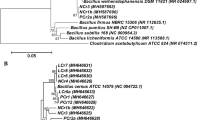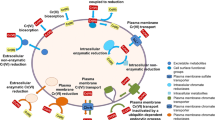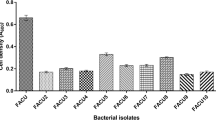Abstract
The toxicity and solubility of chromium(VI) can be decreased by certain microbes that reduce chromium(VI) to chromium(III). However, these bacteria do not escape unscathed from this process. Chromium(VI) reduction damages the essential macromolecules of living systems. Trehalose protects organisms from chemical stress but has not been tested in the context of bioremediation. We engineered bacteria to produce trehalose and found that they then reduced 1 mM chromium(VI) to chromium(III), whereas wild-type cells were only able to reduce half that amount. Thus, by providing bacteria with a biochemical defense against the side-effects of chromate reduction may be a new approach to cleaning up sites that are contaminated with high levels of chromate.



Similar content being viewed by others
References
Ackerley DF, Gonzalez CF, Keyhan M, Blake R, Matin A (2004a) Mechanism of chromate reduction by the Escherichia coli protein, NfsA, and the role of different chromate reductases in minimizing oxidative stress during chromate reduction. Environ Microbiol 6(8):851–860
Ackerley DF, Gonzalez CF, Park CH, Blake R, Keyhan A, Matin A (2004b) Chromate-reducing properties of soluble Flavoproteins from Pseudomonas putida and Escherichia coli. Appl Environ Microbiol 70(2):873–882
Ackerley DF, Barak Y, Lynch SV, Curtin J, Matin A (2006) Effect of chromate stress on Escherichia coli K-12. J Bacteriol 188(9):3371–3381
Aguilar-Barajas E, Paluscio E, Cervantes C, Rensing C (2008) Expression of chromate resistance genes from Shewanella sp strain ANA-3 in Escherichia coli. FEMS Microbiol Lett 285(1):97–100
Anderson RT, Vrionis HA, Ortiz-Bernad I, Resch CT, Long PE, Dayvault R, Karp K, Marutzky S, Metzler DR, Peacock A, White DC, Lowe M, Lovley DR (2003) Stimulating the in situ activity of Geobacter species to remove uranium from the groundwater of a uranium-contaminated aquifer. Appl Environ Microbiol 69(10):5884–5891
Barceloux DG (1999) Chromium. J Toxicol Clin Toxicol 37(2):173–194
Cheung KH, Gu JD (2007) Mechanism of hexavalent chromium detoxification by microorganisms and bioremediation application potential: a review. Internat Biodeter Biodegrad 59(1):8–15
Crowe JH (2007) Trehalose as a “chemical chaperone”: fact and fantasy. Adv Exp Med Biol 594:143–158
Da Costa Morato Nery D, Da Silva CG, Mariani D, Fernandes PN, Pereira MD, Panek AD, Eleutherio EC (2008) The role of trehalose in protection against reactive oxygen species. Biochim Biophys Acta 1780(12):1408–1411
Duman F (2011) Effects of exogenous glycinebetaine and trehalose on lead accumulation in an aquatic plant (Lemna gibba L.). Int J Phytoremed 13(5):492–497
Kaasen I, Falkenberg P, Styrvold OB, Strom AR (1992) Molecular cloning and physical mapping of the otsBA genes, which encode the osmoregulatory trehalose pathway of Escherichia coli: evidence that transcription is activated by katF (AppR). J Bacteriol 174(3):889–898
Kandror O, DeLeon A, Goldberg AL (2002) Trehalose synthesis is induced upon exposure of Escherichia coli to cold and is essential for viability at low temperatures. Proc Natl Acad Sci USA 99(15):9727–9732
Lenski RE (1993) Evaluating the fate of genetically modified microorganisms in the environment—are they inherently less fit. Experientia 49(3):201–209
Mukhopadhyay A, He ZL, Alm EJ, Arkin AP, Baidoo EE et al (2006) Salt stress in Desulfovibrio vulgaris Hildenborough: an integrated genomics a pproach. J Bacteriol 188(11):4068–4078
Purvis JE, Yomano LP, Ingram LO (2005) Enhanced trehalose production improves growth of Escherichia coli under osmotic stress. Appl Environ Microbiol 71(7):3761–3769
Richard FC, Bourg ACM (1991) Aqueous geochemistry of chromium—a review. Water Res 25(7):807–816
Thompson IP, van der Gast CJ, Ciric L, Singer AC (2005) Bioaugmentation for bioremediation: the challenge of strain selection. Environ Microbiol 7(7):909–915
Tropis M, Meniche X, Wolf A, Gebhardt H, Strelkov S, Chami M, Schomburg D, Kramer R, Morbach S, Daffe M (2005) The crucial role of trehalose and structurally related oligosaccharides in the biosynthesis and transfer of mycolic acids in corynebacterineae. J Biol Chem 280(28):26573–26585
Viti C, Pace A, Giovannetti L (2003) Characterization of Cr(VI)-resistant bacteria isolated from chromium-contaminated soil by tannery activity. Curr Microbiol 46:1–5
Yancey PH (2005) Organic osmolytes as compatible, metabolic and counteracting cytoprotectants in high osmolarity and other stresses. J Exp Biol 208(15):2819–2830
Acknowledgments
The authors wish to thank Alfred Goldberg and Olga Kandror for bacterial strains, Ryan Shultzaberger for the pBAD18 construct, and Danielle Dube for comments on the manuscript. This work was supported by a Bowdoin College Faculty Resources Award, by the National Institutes of Health (Grant P20 RR-016463 from the INBRE Program of the National Center for Research Resources), by an award to Bowdoin College by the Howard Hughes Medical Institute under the Undergraduate Science Education Program, and by startup funds from the University of Southern Maine.
Author information
Authors and Affiliations
Corresponding author
Electronic supplementary material
Below is the link to the electronic supplementary material.
Rights and permissions
About this article
Cite this article
Frederick, T.M., Taylor, E.A., Willis, J.L. et al. Chromate reduction is expedited by bacteria engineered to produce the compatible solute trehalose. Biotechnol Lett 35, 1291–1296 (2013). https://doi.org/10.1007/s10529-013-1200-z
Received:
Accepted:
Published:
Issue Date:
DOI: https://doi.org/10.1007/s10529-013-1200-z




